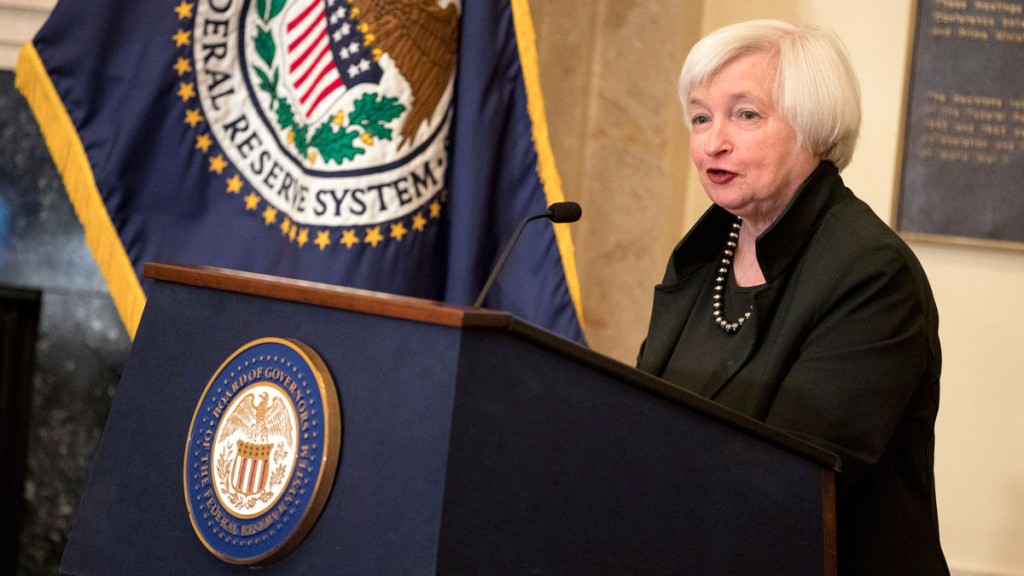
The US Federal Reserve held its first meeting since Donald Trump became president last night (there’s already been one meeting since he was elected, but now it’s official).
There were no fireworks. Nobody expected Fed chief Janet Yellen to raise interest rates, and it certainly didn’t happen.
But one thing did become quite clear: regardless of how much they dislike each other, Trump and Yellen are singing from the same hymn sheet…
Janet and Donald should be best of friends
Janet Yellen and Donald Trump have been set up as adversaries.
Trump was pretty dismissive of her in the run up to the election (although by his standards, his criticism of the Fed has been pretty tame). And Yellen is a Democrat, and closely identified with the Obama administration. So you wouldn’t expect them to click.
And I’ll be honest with you, I did wonder if Yellen was going to chuck a spanner in Trump’s works. Just for fun. But after last night’s meeting, I have to say that it doesn’t look like it.
Let’s be clear here: if Trump shouts and balls about the Fed occasionally, it’s just because he’s pandering to a particular section of the voter base. He’ll talk about blowing up stockmarket bubbles and he’ll criticise money printing because he knows that a certain group of voters respond to that.
But in reality, the last thing Trump would want is a hard currency. Or a strong dollar. Or a return to the gold standard. Or the end of the Fed.
As more than a few people have pointed out to me, Trump is a real-estate guy. Real-estate guys love low interest rates and cheap debt. They thrive on that stuff. This is not a man who is keen to see interest rates go up.
On top of that, he wants a manufacturing renaissance in America. Try doing that with a strong dollar. That’s why his trade representative, Peter Navarro, was getting stroppy with Germany the other day and accusing them of reaping unfair benefits from the euro. (And there’s some truth to what he says, whether you approve of how he said it or not.) They’ve also been targeting Japan’s monetary policies.
So Trump wants two things: low rates and a weak dollar. That is exactly what Yellen has been striving to maintain for her entire time as Fed governor.
Since Alan Greenspan was in charge, the Fed has been terrified of doing anything that causes a triple-digit drop in the Dow Jones index. And Greenspan’s successor Ben Bernanke was always very clear that the Great Depression was basically the Fed’s fault. So there’s a fundamental institutional and intellectual bias towards keeping monetary policy as loose as possible.
That means that Trump and Yellen are on the same page when it comes to rates. At the end of the day, whether she denies it or not, Yellen would much rather err on the side of caution and inflation, than risk raising interest rates too early and causing a deflationary crash.
The reflation trade
Now, as I said above, I did wonder if Yellen would throw that caution aside and cheerfully drive the economy into a wall (or at least, act as if that was no longer a concern of hers), just to screw Trump up. But it certainly doesn’t seem to be on the agenda after yesterday’s meeting.
Rates didn’t rise. And there wasn’t any real change from the language used in December. The economy “continued to expand at a moderate pace”. Job gains “remained solid”. Inflation has gone up, but it’s still below the US central bank’s long-run 2% target.
Now, bear in mind that yesterday – in the absence of any “fiscal stimulus” or anything else – both employment data (the ADP payrolls – not the main reading, but one that people do watch), and manufacturing data absolutely trounced expectations. Regardless of your feelings on what Trump means for the US, or the “authenticity” of the recovery, or anything else, the US economy is not running cold.
There are lots more people in jobs. Manufacturing is booming, if yesterday’s data is anything to go by. And inflation is picking up.
For the Fed not to take much interest in this all suggests that Yellen is still keen to err on the side of caution (in other words, on the side of inflation) when it comes to raising interest rates.
The consensus was for a stronger dollar when the year started (just as it was in 2016). It was extremely hard to come up with reasons why that might not be correct. And yet, between the Fed playing it safe, and Team Trump’s various attacks on the dollar, it looks like the consensus might be – well, plain wrong – yet again.
Don’t get me wrong. I wouldn’t be rushing out to stick on loads of currency trades based on this. The Fed can make various speeches between now and its next meeting in March, and tweak the market’s expectations that way. And tomorrow’s payroll data – the jobless figures – could change the market’s mind again.
But it seems pretty conclusive to me that in the longer run, there’s no change in policy here. The US will keep rates as low as it can for as long as it can, and the tightening won’t start unless and until inflation becomes less politically palatable than a falling stock market.
I suspect that’ll take a while. So stick with gold and your other reflationary trades. And try to ignore all the noise from Trump’s direction.